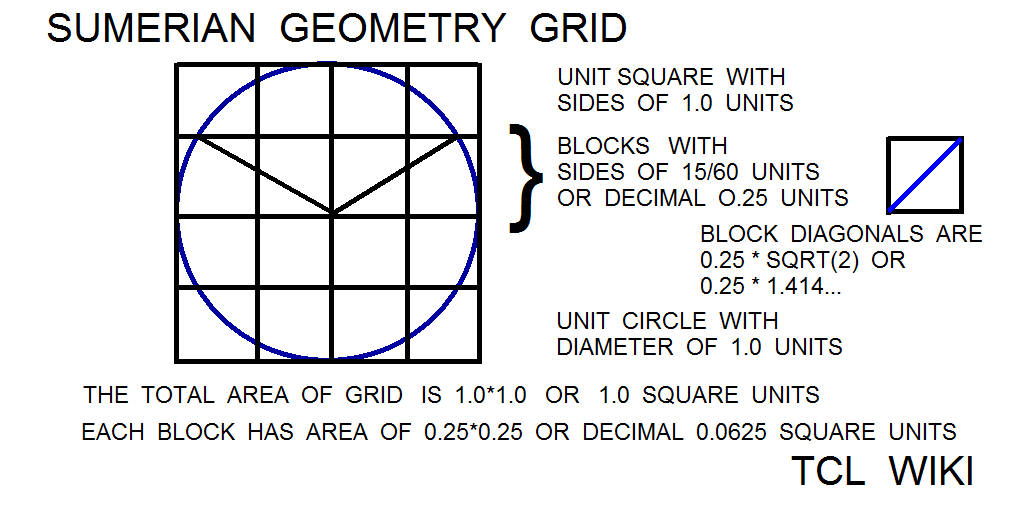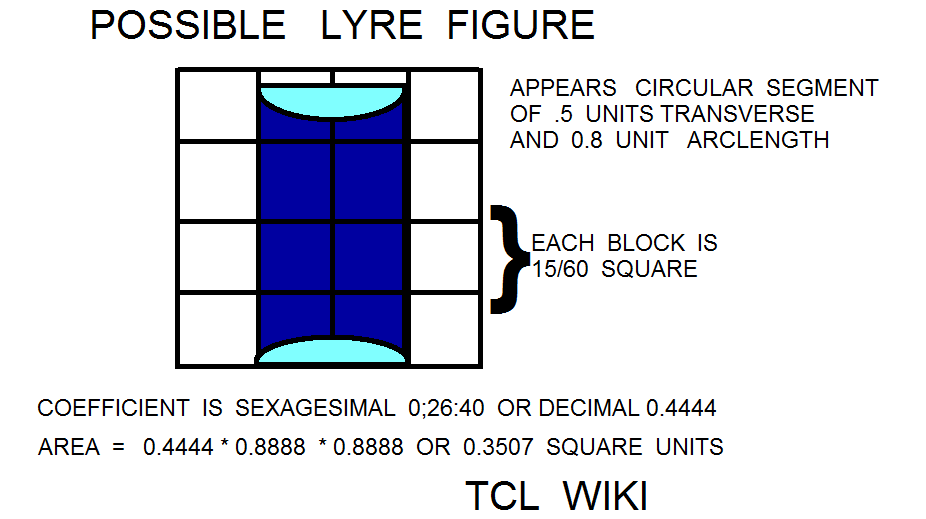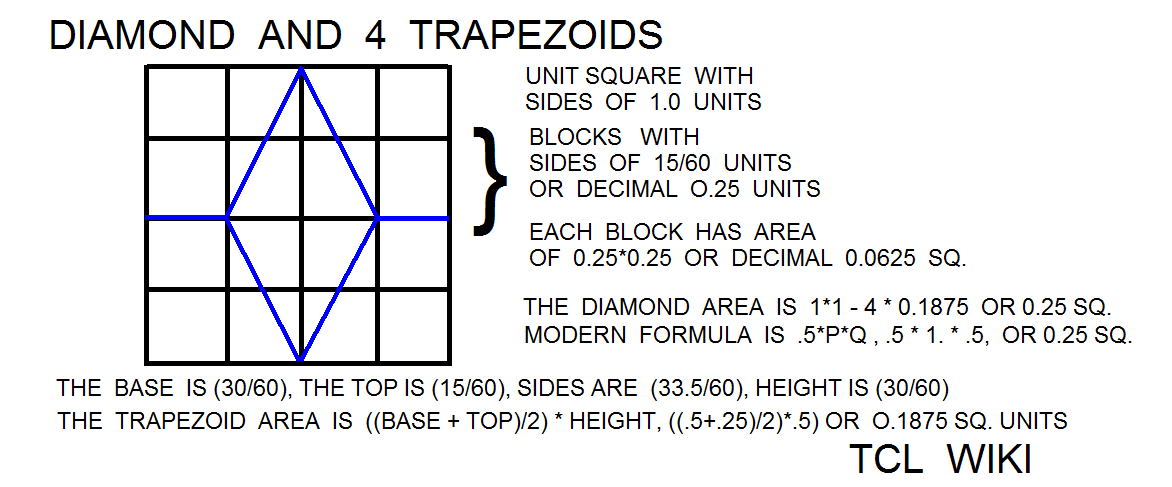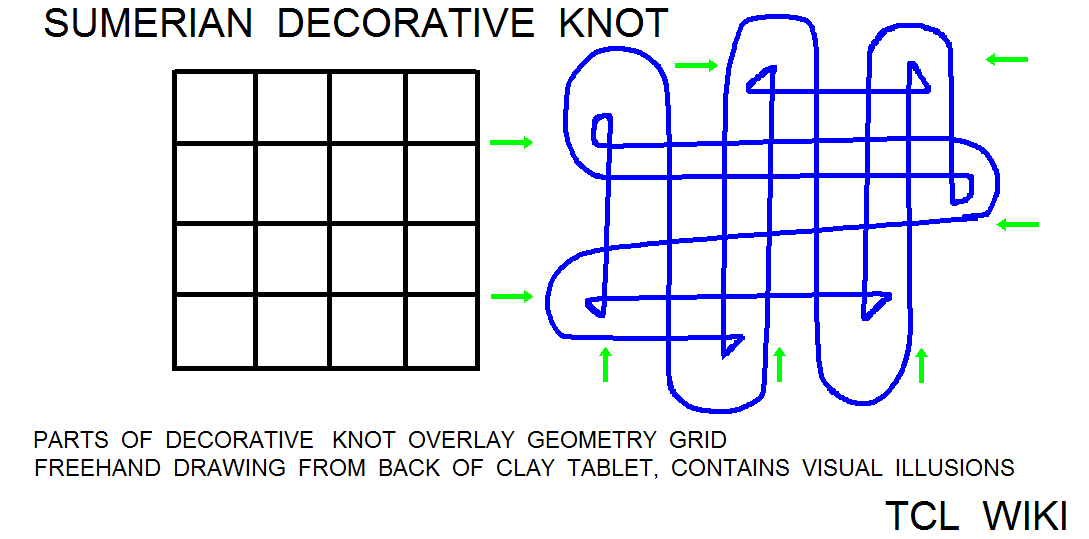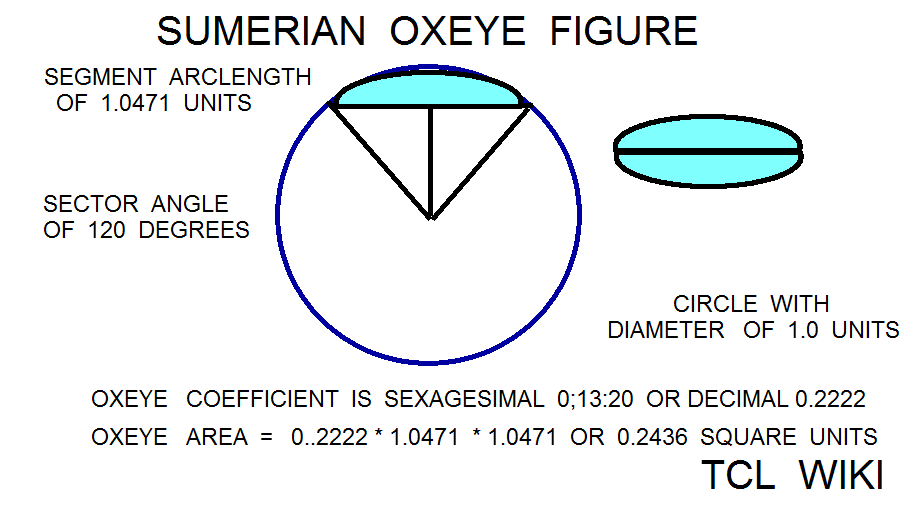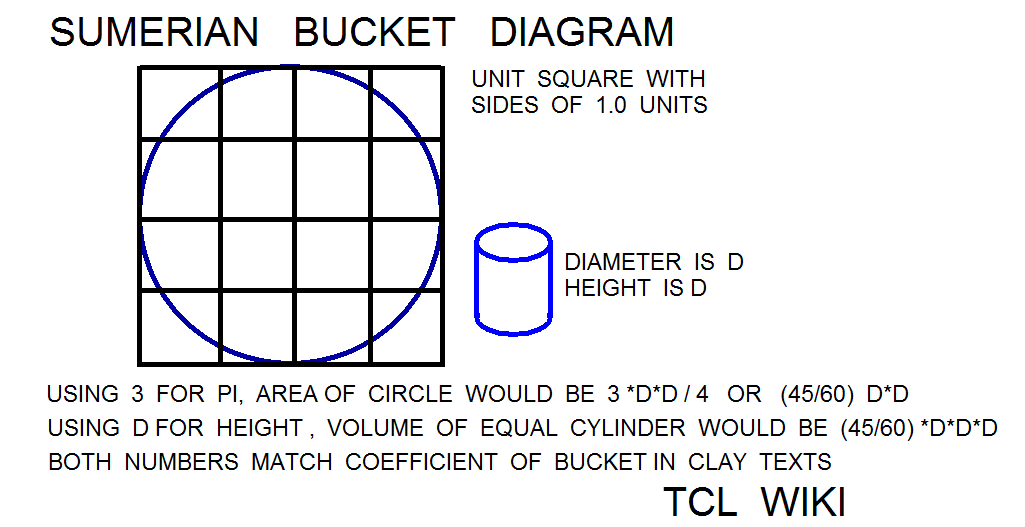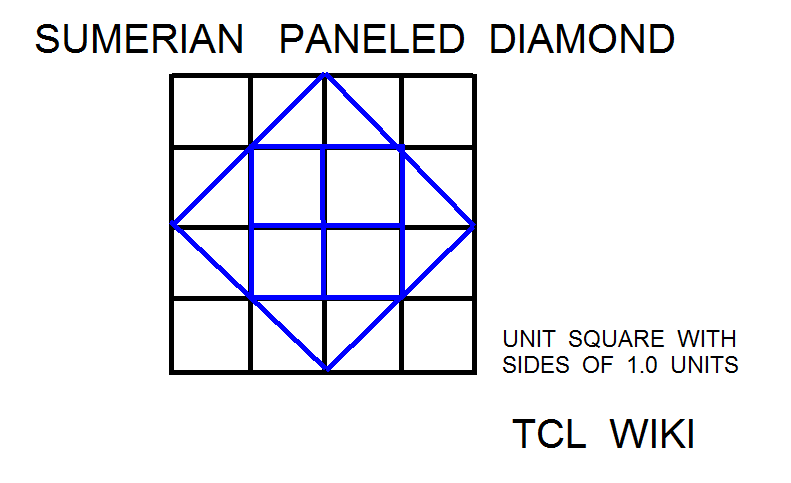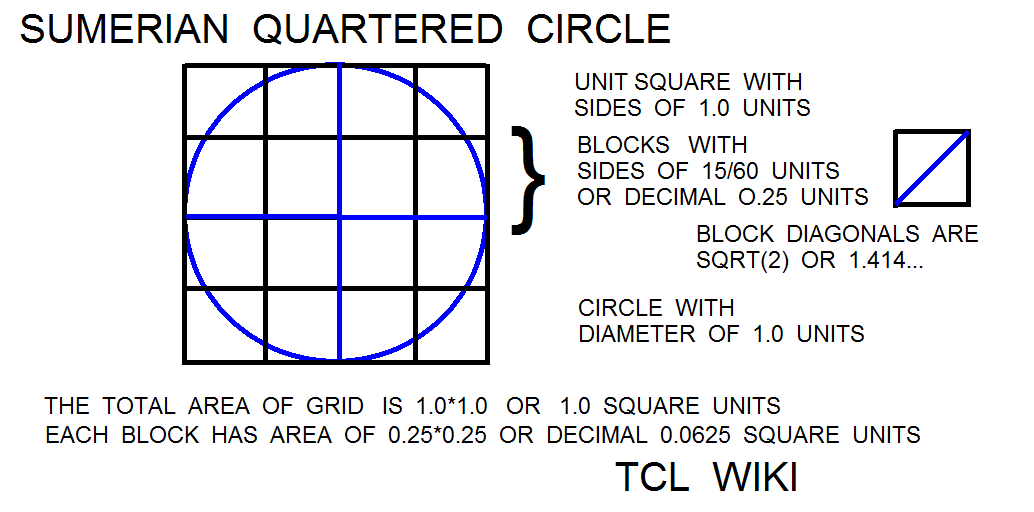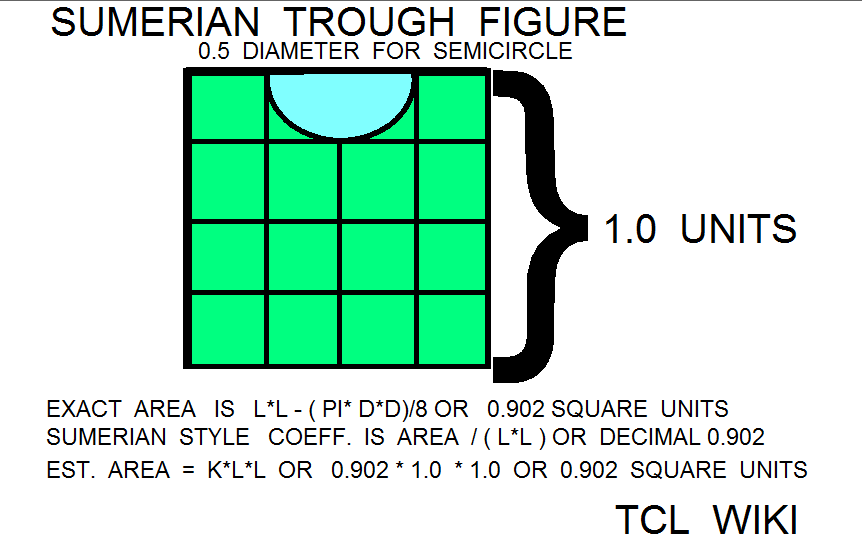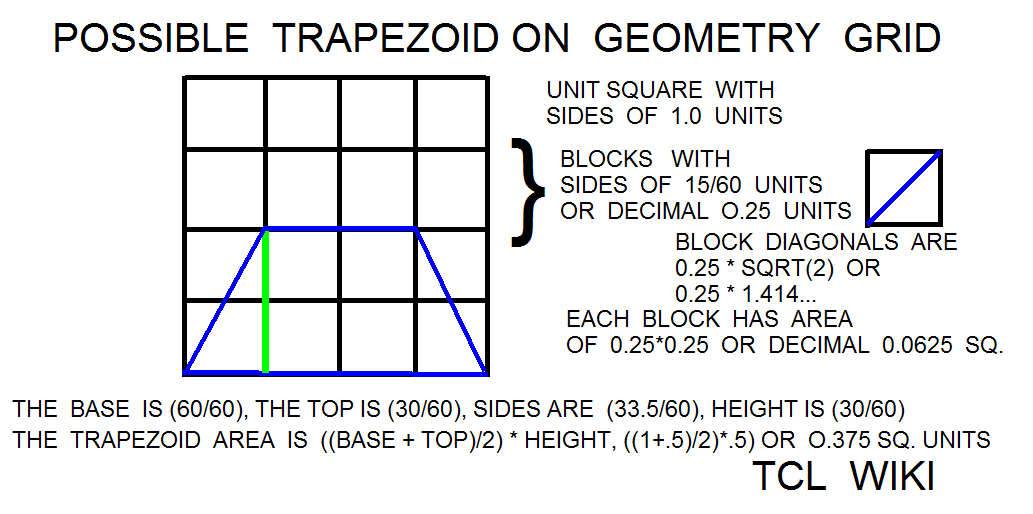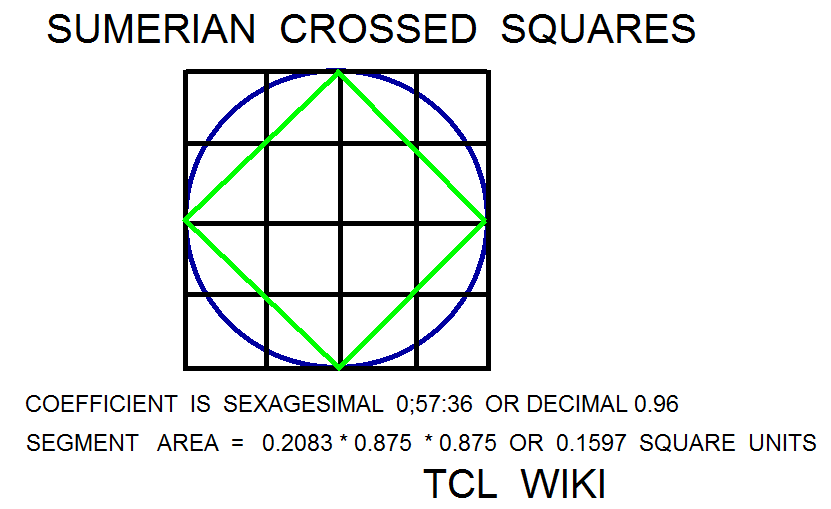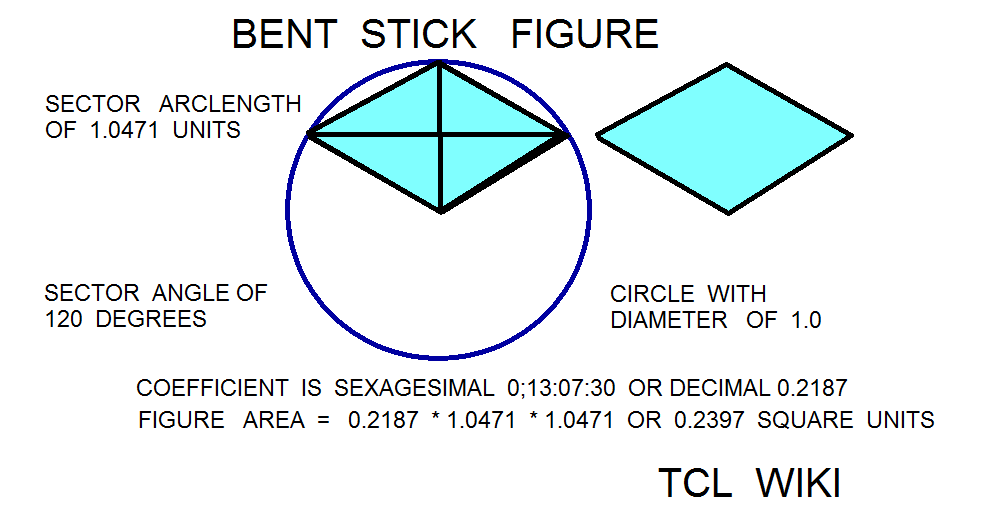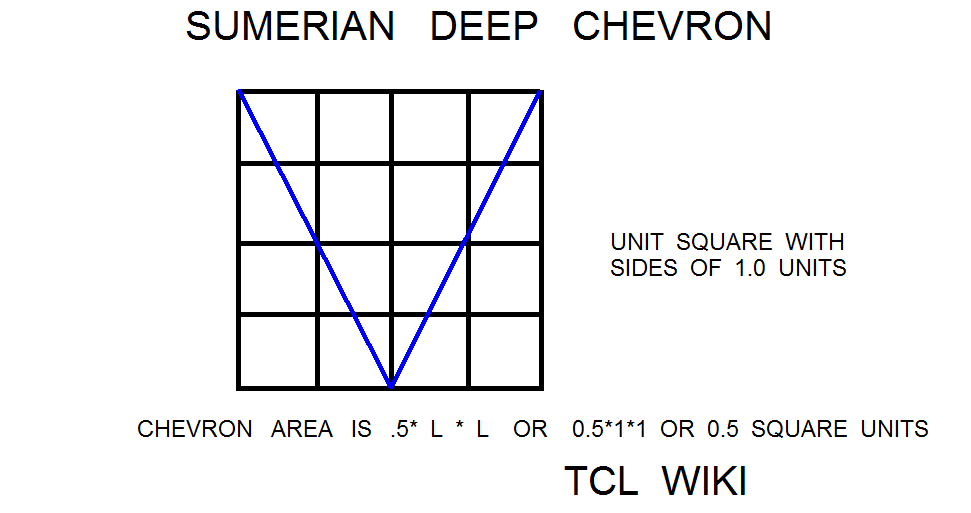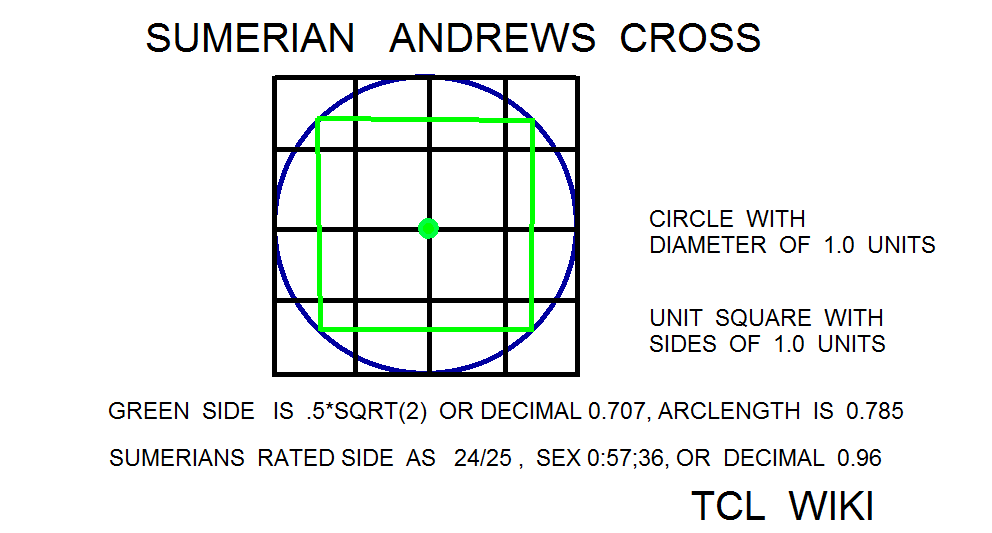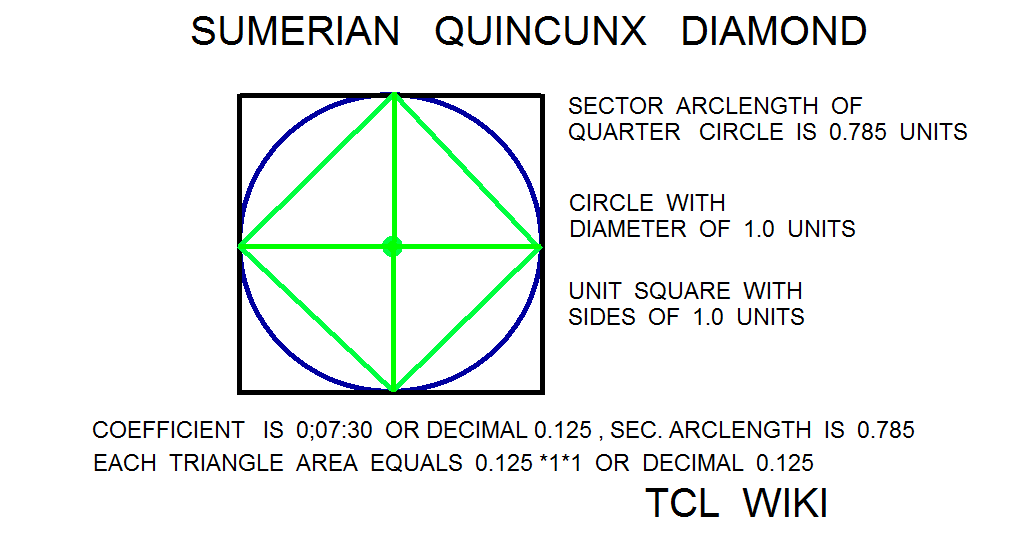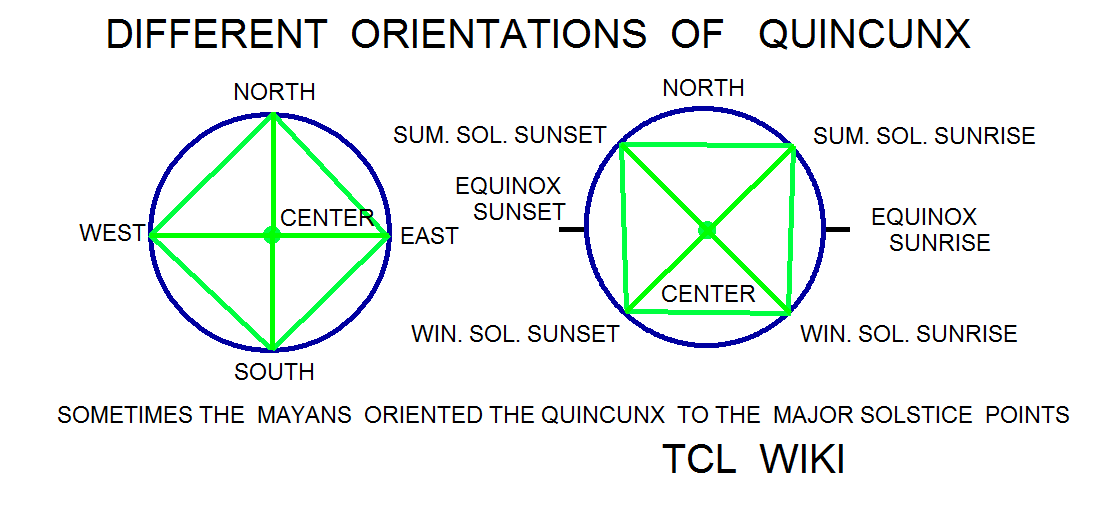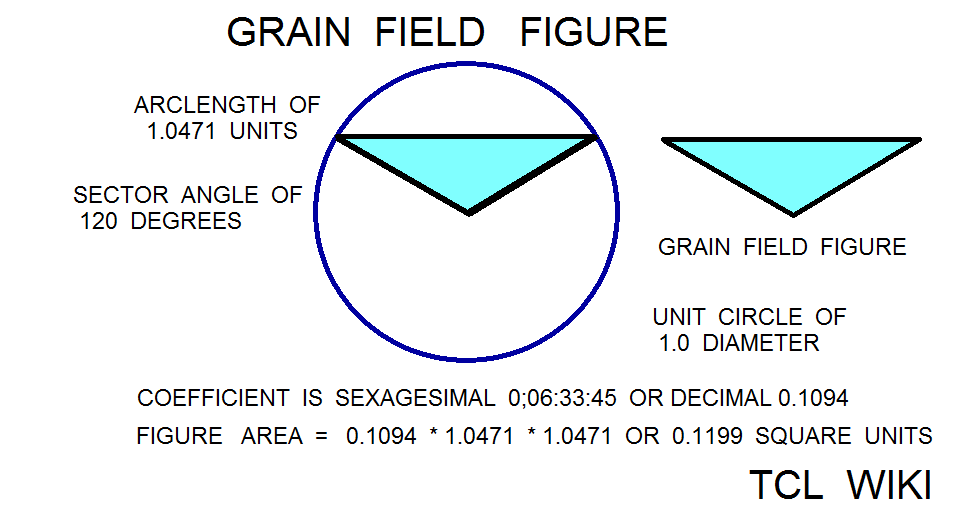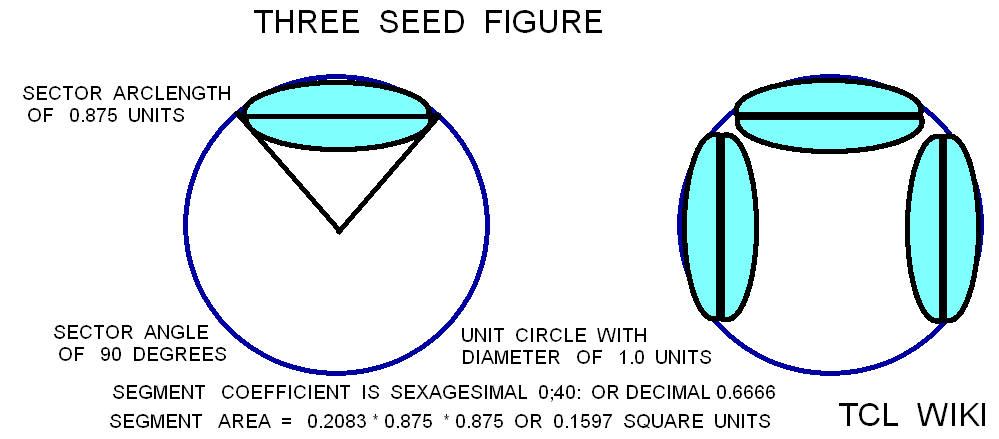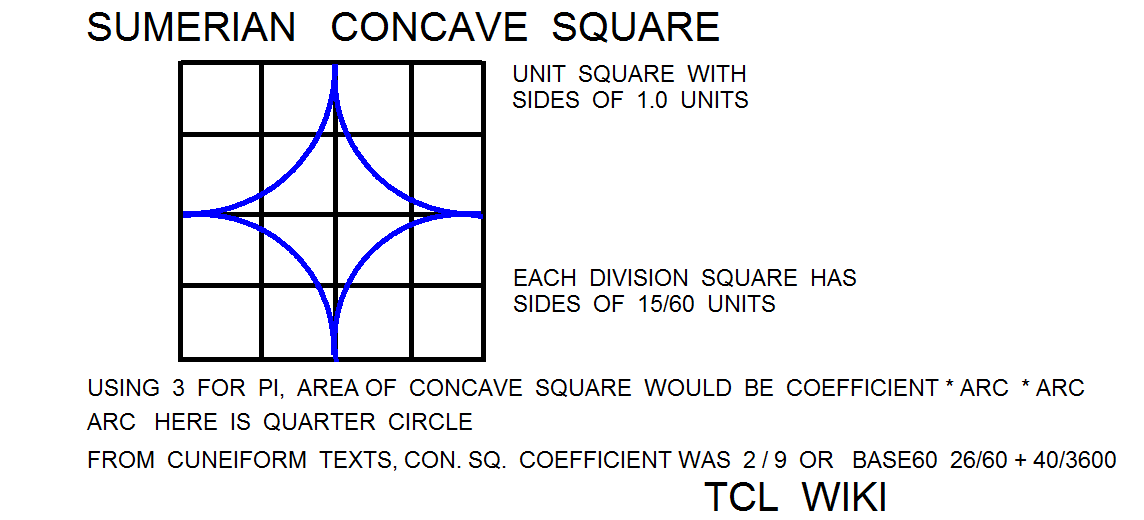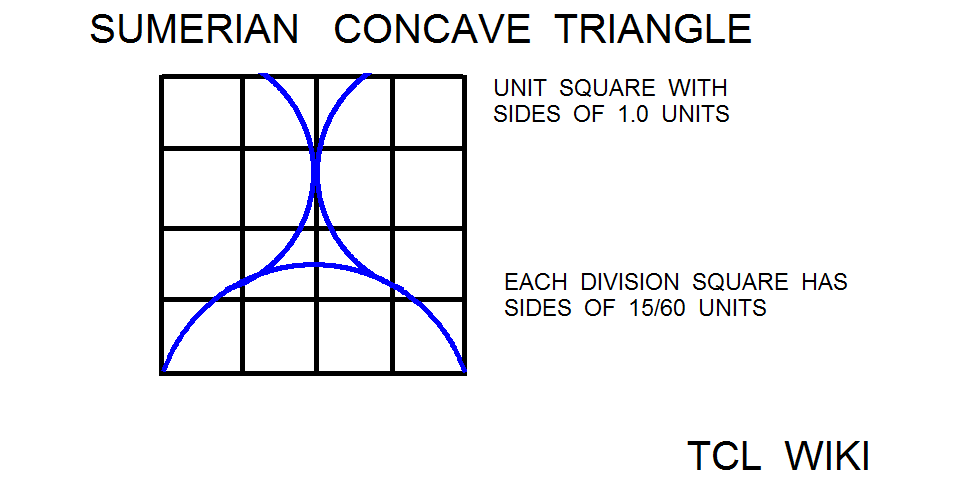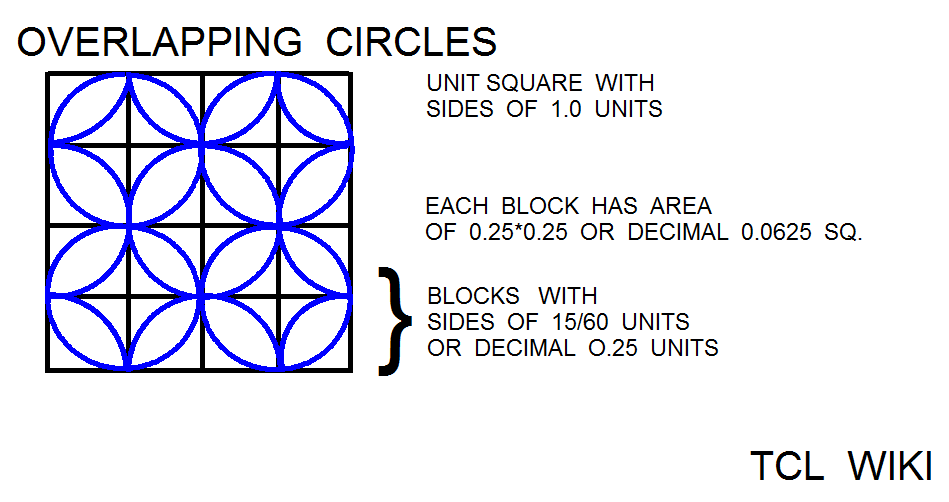Sumerian Circular Segment Coefficients and Calculator Demo Example
Sumerian Circular Segment Coefficients and Calculator Demo Example
This page is under development. Comments are welcome, but please load any comments in the comments section at the middle of the page. Please include your wiki MONIKER in your comment with the same courtesy that I will give you. Its very hard to reply intelligibly without some background of the correspondent. Thanks, gold
gold Here is an eTCL script on Sumerian geometric figures called the bow and barge figures. I have modified a slot calculator in eTCL to handle calculations for circular segment area and the Sumerian bow coefficients. On clay tablets, the Sumerians were defining and calculating the area of geometric bow figures, effectively finding the double area of a circular segment in modern terms. The Sumerian bow coefficients were given as bare numbers in base 60, without much explanation. The extant geometric segment coefficients are based either on a circular segment of either 90 or 120 degrees. At this point, its easier to use modern trig equations in the eTCl calculator and compute the segment area accurately. Then try to understand how the Sumerians developed their geometric coefficients. Although the geometric coefficients were passed through successive cultures as late as 400 BCE, the main compilation of the geometric coefficients was probably during the King Naram-Sin reforms of the Akkadian empire in 2150 BCE.
The previous publications by Vaiman (1963),Von Sloden (1964), and Robinson (1999) found that most sexagesimal bow coefficients were developed from a 120 degree segment of circle of 1 unit diameter. Further, the unit circle was imposed on a square grid of 1 unit by 1 unit total. The square grid can be broken down either into 4 vertical strips at 15/60 width and 1 height or into 16 squares of 15/60 on a side. The initial segment or bow figures were contained in vertical strips measured at 15/60 width and 1 height. On tablet BM15285, some of the designs show compass marks and line construction marks of a partially erased 16 square grid. BM15285-p14 shows the 16 square grid as a math problem on what is the area of a subdivided square. On clay the incised lines can be erased by rubbing with a wet thumb. Aside from the construction traces, the 16 square grid can be inferred from some figures which either follow grid lines or are placed inside subsquares or strips, like BM15285-p31, p32, and p34. On BM15285, the larger squares are 48 mm on a side and most of circles are 22 mm in diameter. Over the years of the modern era since the tablets have been discovered, there have been several comments that the designs of squares and circles and are skewed or not perpendicular. For the small scale of the designs and the medium, the designs are reasonably square and are close in scale to the older printed circuits of the 1970's. Until the invention of the Postscript language, most of the modern book designs were drawn on a drafting table and reduced photographically.
In Sumerian geometry, constructing a circular segment of 120 degrees on the unit circle results in a triangle of two equal sides, a circular segment, and an implied arclength of the segment. The bow figure is a single segment and the barge figure is a double segment. The triangle figure is called the grain field figure from the triangles used in land surveying. The arclength of the circular segment was used as a reference length for calculating the area of geometric figures, using various coefficients. One given set of generating coefficients was sexagesimal 0;52,30 transverse of bow, 0;6:33:15 bow area coefficient, and 0;30 generating radius of bow. When the generating radius of decimal 0.5 is marked from the center of the grid, an boundary of a 15/60 end strip will define the long transverse of the bow or bowstring length. The width or short transverse of the bow is 0.5-(15/60) or 0.25. There will be two right triangles of sides 15/60 and 30/60. By Pythagorean theorem, the remaining side is sqrt((30/60)**2 + (15/60**2)), which is 26/60. The bowstring length was 2*(26/60) which is 52/60 or sexagesimal 0;26 or decimal fraction 0.866. The area of the bow figure would be the area of the 120 degree section minus the area of the combined triangles. Calculating, (1/3)*pi*(.5**2)-2*((1/2)*((15/60)*(26/60)) would be decimal fraction 0.26179 - 0.108330 or decimal 0.15346. The eTCL calculator gives an area of decimal 0.1535 square units for the bow.
For the 120 degree circular segment, the reference length is (120/360)*2*PI*r. For the unit circle of diameter 1 and radius 0.5, the reference length is (120/360)*2*PI*.5 or 1.0471. The segment length or bowstring length is the reference length times the sexagesimal 0;52:30 or decimal 0.875. The segment height or bowstring width is the (generating radius) - (distance to chord), .5-.25 or 0.25. The coefficient of the triangle or grain field figure is sexagesimal 0;06:33:45 or decimal 0.1094. The Sumerian generic area formula would be grain field area = coefficient * transverse * transverse or using decimals 0.1094*1.0471*1.0471 or 0.2166.
There are also constants for a barge figure based on a 90 degree sector. The barge figure is a double segment and is also associated with a seed figure in some texts. In the coefficient tables, the Sumerians give the reference length as sexagesimal 0;52:30, or (52/60+30/3600) or decimal 0.875. The clay tablets give the barge figure coefficient as sexagesimal 0;13:20, (13/60+20/3600), or decimal 0.2222. The Sumerian generic area formula would be barge area = coefficient * transverse * transverse or using decimals 0.2222*0.875*0.875 or 0.1369 square units. The double segment area from a trig formula reduced for a 90 degree segment is 2*((PI*r*r)/4-(r*r/2)), 2*((PI*.5*.5)/4-(.5*.5/2)), or 0.142699 square units. The eTCL calculator figured the double segment area was 0.1426 square units. The Sumerian error for the barge area would be (clay given constants)/(modern trig) or 1-0.1369/0.1426, or 3.9 per cent low. From the Robinson paper, the Sumerians appear to be using Heron's approximation for an equilateral triangle as 1-(w**2)/2, 1-((30/60)**2)/2, or decimal 0.875. The Sumerian overage or error for the reference length would be (clay given)/(modern trig) or 1-0.875/.866, or 1.04 per cent high. The Sumerian tablet gives 0;12:30 barge area coefficient 0;12:30 or (12/60+30/3600), or decimal 0.20833. Solving for the constant from the formula, the constant equals barge area / (transverse * transverse). The barge coefficient is recalculated as 0.20472 in modern trig. The Sumerian overage or error for the barge coefficient would be (clay given)/(modern trig) or 1-0.20833/0.20472, or 1.76 per cent high.
For the 90 degree segment with the unit circle of diameter 1 and radius 0.5, the reference length is (1/4)*2*PI*.5 or 0.785. The bowstring is approximately (sqrt 2)/2 or 0.7071. The bowstring length is the reference length times the sexagesimal 0;56:40 or decimal 0.9444. The bowstring width is the reference length times the sexagesimal 0;28:20 or 0.4722.
The tablet TMS025 gives a throwing stick or rhombus area of sexagesimal 0;13;07;30 or decimal 0.21874. The throwing stick coefficient could be checked in reference to the eTCL calculator. The sexagesimal 0;13;07;30 has the terms of 13/60 + 7/3600 + 30/216000, which is a precision of order 30/216000, 3/21600, or 1/7200. The Robinson paper indicates the throwing stick or rhombus figure is mapped on a 120 degree sector of a circle. In this case, the area of a rhombus is 0.5* short transverse * long transverse, 0.5*0.5*0.875 or 0.21875. The coefficient is k/(T*T), 0.21875/(0.875*0.875), decimal 0.28571 or sexagesimal 0;17,8,24 (not found on the tablet).
There are coefficients for second and third bow figures. The coefficient for a second semicircle coeff may be for quarter circle. One half the rhombus figure is composed of the 2 right sided triangles calculated above. The summed area of four triangles 4*((1/2)*((15/60)*(26/60)) or decimal fraction 0.2166. Solving for the constant from the formula, the constant equals rhombus area / (transverse * transverse) or 0.2166/ (0.866*0.866) or 0.2838.
The Sumerians used the circular segments as components is other geometric figures called 2 seed and 3 seed figures. A seed was two circular segments matched together in the gridded circle, forming a seed or beanlike shape. The sum of two seeds was 2*.1406 or 0.2812 square units. The sum of three seeds was 3*.1406 or 0.4218 square units. In the tablet reference there were one coefficient 16/60 for the 2 seed figure and a line marked 16 26 46 40 for the 3 seed figure. The line marked 16 26 46 40 was difficult to interpret, but based of the appearance of similar numbers in other lines may mean 3 separate numbers such as 16/60, (26/60 + 46/3600), and 40/60. The transverse or reference length would be unknown or uncertain in the 3 seed figure, since there are several axis' and perimeters to chose from. Possibly, the reference length would be approximately the square root of the term (area/coefficient), sqrt(.2812/.4461), decimal 0.793 or sexagesimal 0;47:45. The reference length for the seed figure (.5 * perimeter) from the 90 degree sector was 0.785 or sexagesimal 0;47:6. The combined area for the three seed figure from the formula would be seed area = coefficient * T * T, 40/60*0.785*0.785, or 0.4108 square units. The error would be modern area formula/Sumerian equation,1-0.4218/0.4108, or 2.6 per cent.
The number 16 or 16/60 applied to both the 2 seed and 3 seed figures. The area units (gan) of 0;5:24 (0.09) and 0;45 was reported from a corrupted text. The 0;45 or 3/4 was believed to be associated with quarter circle areas or quarter ratios. The area of one seed was .1406 or (8/60+26/3600). The reduced ratio of seed plus circle / circle area was 2-PI/4 , 0;43:36... or decimal 0.7266.
The early assumption in solving the Sumerian seed figures was that all seeds have to be placed on the rim of the circle, but there may be some wrinkles in store. The 90 deg sectors would be up to three seeds placed on the rim; the coefficients would be 0.2083 (1 seed),.4171(2 seeds),0.6666(3 seeds), 0.8332 (4 seeds) or N *0.2083, 1<=N<=4. The 120 degree sectors would be up to three seeds placed on the rim, as follows 0.2436 (1 seed),0.4872 (2 seed),0.7308(3 seed),or N*0.2436 & 1<=N<=3. Even with the confusion or corrosion in some coefficient lines, the associative principle suggests that the solutions are interrelated multiples. Also, it could be pointed out the coefficients compute the area of the seeds correctly, even if the seeds are not placed on the rim. From tablet BM15285-p40, it is found that smaller seeds ( of smaller diameter circles than the unit circle ) can be placed inside the unit square. Also, if we consider that smaller seeds can be placed inside squares and circles, the placement of seeds does not necessarily have to be placed on a circular rim. Seeds with transverses smaller than the 0.5 radius of the unit circle could be placed like roseate petals at the center of the unit circle. Some petal designs with 3,4,etc petals inside a circle have been found in designs like the 8-pealed symbol of Ishtar. It is also possible that seeds could be placed in row arrangements or randomly inside a circle or square.
The bullseye geometric figure was an annulus or ring figure defined by an inner radius of r1 and an outer radius r2 of 4*r1. Plotted on the unit circle of diameter 1 and a grid of 15/60 squares, the inner radius was (1/2)*(15/60) or decimal fraction 0.125. One line of the clay text cited the outer radius as 0.5. Somewhat inconsistently, another line listed the outer diameter of the bullseye as sexagesimal 0;53:30 or decimal 0.875. The 0;53:30 diameter was defined from the 120 degree circular segment. From the 1:4 ratio, the area of the outer circle was 16 times the area of the inner circle. Also from the 1:4 ratio, the outer area was 15*pi or roughly 3*15 or 45 times the radius of the inner circle, using the Sumerian PI or 3. There are some Sumerian math problems, where the bullseye and cylinder figures were used as a model for a brick kiln. The bullseye area times the height of the kiln was used to estimate the volume and number of bricks inside the brick kiln. The outer ring area times the height of the kiln was used to estimate the volume or amount of fuel (wood or asphalt). In the excavations of Jericho, broken ceramic pieces were found in circular pits, which might have been kilns.
The gis-za-mi (wood sound hymn) or lyre geometric figure was given in the tablets as two numbers. The lyre coefficient was sexagesimal 0;26:40 or decimal 0.444. The reference length or transverse of the lyre was sexagesimal 0:53:20 or decimal 0.8888. A corroded tablet was found with the label gis-za-mi near a figure that looked like a rectangle with two concave bow faces. A tentative rectangle can placed and estimated on the 16 square grid. The Sumerian generic area formula would be lyre area = coefficient * transverse * transverse,= 0.444*0.8888*0.8888., decimal 0.3507 or sexagesimal 0;21:3. Each component square on the grid has the area (15/60)*(15/60) or decimal 0.0625 square units.
Since the dimensions of the 2 bow segments for the lyre figure are unknowns but small unknowns, certain inequality statements can be developed suggest the width of the lyre. The tentative lyre area would be rectangle area minus 2 bow areas, length * width - small unknown , .8888*.5 - 2*~ or 0.4444 - 2*~. Dropping the small unknowns for an inequality, then the lyre area would be less than 0.4444 square units. For another similar inequality, the rectangle area minus 2 bow areas equals Sumerian formula, L*W- 2*~ = k*L*L, L*W- 2*~ = 0.444*L*L., L*W =0.444*L*L + 2*~, then W =0.444*L + (2*~)/L. Dropping the small unknowns for an inequality, W => 0.444*L, W => 0.444*0.8888, W => 0.5 units . Since blocks are .25 on a side and 0.5/.25 gives 2, W=> 2 blocks. As a minimum, the lyre width would be greater than area/length, 0.3507/0.8888, or 0.394 units. In terms of blocks, the lyre width would be greater than 0.394/(15/60) or 1.5 blocks. For another inequality, since a square or L*L would be the maximum area, it follows that k*L*L<=L*L and W*W<=L*L; so W<=L and W<= 0.8/.25 or 4 blocks. The number of squares in the lyre figure would (lyre area)/(square area of block), 0.3507/0.0625 or roughly 5.6 squares. Combining the inequalities, 2. blocks =< W =< 4 blocks. So the width of the lyre figure was probably 0.5 or 2 blocks on the 16 square grid.
For the bow segments on the lyre, there are several possibilities. With the calculator, a set of possible arcs or bows were examined. The bow in a 120 degree segment was 0.866 length, width 0.25, and area 0.0495. The bow in a 90 degree segment was 0.7071 length, width 0.1464, and area 0.07149. A small bow in a 132 degree segment was 0.458 length, width 0.15, area 0.0495, and generating radius 0.25. The small bow seemed the best fit on the 16 square grid.
The Sumerian trough figure has some similarities to the lyre figure, there is a bow or semicircle set into the top of a rectanguloid. Only the bare sketch is available here, the Sumerian methods are carried out as an example. Surface area and area coefficients are inferences beyond the bare sketch. From the sketch, the trough figure can be modeled on the 16 square unit grid of overall length L (eg 1.0) . The semicircle has a diameter of (30/60)*L and reaches (15/60)*L into the top of the square. There is a length of (45/60)*L between the bottom of the semicircle and the base of the square figure. The area of the trough figure is L*L-area of semicircle, L*L-pi*diameter*diameter/8,1*1-pi*.5*.5/8, 1.-0.0982 or decimal 0.902 square units. The trough area coefficient would be area / (reference length * length), 0.902/(1.*1.), or decimal 0.902 square units. For another inference, the trough figure is pretty close to a unit square of side L. The square area coefficient would be L*L / (reference length * length), (1.*1.)/(1.*1.), or decimal 1.0 (ref. Friberg, 1987-90). There were several kinds of lyres and there were lyres with square sound boxes pictured on Greek coins. The semicircle or trough allowed the fingers better access to the lower part of the strings.
The ges-pan (wood bow) figure seems similar to the barge figure. The clay tablets give the wood bow area coefficient as sexagesimal 0;12:30, (12/60+30/3600), or decimal 0.2083. The reference length is given as sexagesimal 0;52;30 or decimal 0.875. The Sumerian generic area formula would be wood bow area = coefficient * transverse * transverse or using decimals 0.2083*0.875*0.875 or 0.1595 square units (a double segment). The reference length 0.875 implies the ges-pan figure was developed from the 90 degree sector. There is enough difference in the barge coefficient (0;13:20) and the wood pan coefficient (0;12:30) to suggest some different derivation in the terms. The difference seems to be whether the unknown side of the triangle is estimated by Pythagorean theorem (result:15/60) or Heron's formula (result:26/60+25/3600).
The coefficient list has a bucket coefficient as 0;45 or decimal 45/60. Making assumptions, the bucket had a diameter of 1 and a height of 1. Using 3 for pi, the bucket volume would be (3*diameter*diameter/4)*diameter, (3/4*diameter cubed, or (45/60)*diameter cubed. Here a problem text is needed to find out if the bucket was used as a quantity or formula. Several problems have the one man assignment for removing soil as 20/60 of a gar*gar*kus(volume unit), but context of buckets is uncertain. A silitum or heap of soil is 20/60 sar volume, which appears to be the work assignment of one man. Since a Sumerian yoke load would be 2 talents or 60000 grams in modern units, a single bucket or basket probably carried 30000 grams at least. An Egyptian artabe held 37.78 liters, equivalent to 30.28 kg of wheat. A Babylonian panu was 36 liters or 28.85 kg of wheat. In lieu of more specific texts, a Sumerian bucket or basket (dusu,gis-u-sub,pisannu) was probably between 30 and 36 liters, water equivalent between 30 and 36 kilograms.
The subdivided square is called the quincunx diamond, which was also known among the ancient Chinese and Mayans. Quincunx means 5 portions, counting the center and 4 cardinal directions. Sometimes, the Mayans oriented the quincunx was oriented to the four points of the equinox(2) and the solitice(2). Among the Mayans, the 2 solar overhead or crossover points were sometimes added to include 7 points.
The key to understanding many of tbe Sumerian geometric coefficients and figures is the 16 square grid with the unit square and unit circle. Even some enigmatic figures turn out to be based on the 16 square grid. The complex knot design was found on the back of a clay tablet, perhaps as a decorative book cover. The freehand drawing contains many visual illusions. Some parts of the decorative knot overlay the 16 square grid, including the rope straight lines and turns.
Pseudocode and Equations
#derivation of barge figure setup based on quarter circle segment, ref Robson and Katz. barge_area =2*((pi*r*r/4)-r*r/2) # 2 times segment of circle for quarter section. barge_area = coefficient * (1/4)*circumference * (1/4) *circumference coefficient = barge_area / ( circumference * circumference) coefficient = ((2*pi*r*r/4)-2*(r*r/2) ) / (1/4)*(1/4)*( 2*pi*r * 2*pi*r ) coefficient = ((2*pi*r*r/4)-2*(r*r/2) ) / (pi*r/2)**2 reduction >> coefficient = 2*((pi-2)/(pi*pi)) set modern_decimal_notation [eval expr 2.*(([pi]-2.)/([pi]*[pi])) ] # 0.23133503779823025 # text uses Sumerian 3 for PI, extra decimal points used to check # calculator, not to infer greater accuracy from clay tablet numbers. set sumerian_value_in_digital [eval expr 2.*((3.-2.)/(3.*3.)) ] # 0.2222222222222222 set sumerian_error_fm_3_for_pi [eval expr 0.231335037798230/0.2222222222222-1. ] # 0.041007670092139126 set error_percent [eval expr [* 100*0.041007 ] ] # undershoot 4.1 percent # Sumerian text = 2/9 , 2/9 = 0.2222 decimal, base60 value = 13/60+ 20/3600
#derivation of bullseye figure setup based on 1/3 circle segment, ref Robson and Katz. oxeye_area # 2 times segment of circle for 1/3 section. oxeye_area = coefficient * (1/3)*circumference * (1/3) *circumference coefficient = oxeye_area / ( circumference * circumference) oxeye_area = coefficient * (1/3)* circumference * (1/3)* circumference # triangle area in 1/3 section is equilateral triangle of (1/4)*r*r*sqrt(3) oxeye_area = 2*( pi*r*r/3 - (1/4)*r*r*sqrt(3) ) / (1/3)*(1/3)* 2*pi*r* 2*pi*r coefficient = 2*( pi*r*r/3 - (1/4)*r*r*sqrt(3) ) / (2*pi*r/3)**2 ??? reduction >> coefficient = 2* 9* sqrt(3) / 16*pi*pi ??? coefficient = 2* 9* 7/ 16*3*3*4 = 9*7 / 2*16 # bullseye coefficient 9/32 16_52_30, 16/60+52/3600+30/21600 in base60 sqrt(3)=~7/4
# derivation or problem of crossed square inside square , ref Robson and Friberg set area_square_inside_square [ eval expr 1.-4.*(1./2.)*(2./4.)*(2./4.) ] # area = 0.5 set side_square_inside_square [ eval expr sqrt .5 ] # side = 0.707
# derivation or problem of concave triangle, ref Robson and Friberg set concave_triangle_coefficient_babylonian_notation [ eval expr (7./4.) - (1./2.)*3.] # 0.25, base60 coeff. = 15/60 set concave_triangle_coefficient_decimal [ eval expr [sqrt 3. ] - (1./2.)*[pi] ] # 0.16125448077398064
# derivation or problem of concave square, r=.5, d=1.0, ref Robson and Friberg # square of unit one on side minus 4 quarter circles of radius ,sumerian pi = 3. # problem wants quarter circle arc equal one. # coefficient is 4 times area of inscribed quarter_circle with arc of quarter_circle set to 1. arc of quarter_circle= 2*pi*radius, radius = (2/pi)*arc, setting arc =1, radius=2/pi area of square using radius is (2/pi)* (2/pi) area of quarter_circle is (1/4)*pi*radius*radius, subbing (1/4)*pi*(2/pi)*(2/pi) expression 4* < (2/pi)**2- (1/4)*pi*(2/pi)**2 > set concave_square_area [ eval expr 4.* ( 4./([pi]*[pi])- [pi]/([pi]*[pi]) ) ] # using modern pi, 0.34789939354224164, modern pi gives substantial difference from text value substituting 3 for pi ,concave_square =4.* ( 4/9-(3*4)*(4/9)), answer = 4/9, conv (4/9)*60+ ( remainder 4/9)*60. Sumerian text = concave_square_area = base60 26_40, 4/9 concave_square_area = coefficient * quarter_circle_arc* quarter_circle_arc concave_square_coefficient = concave_square_area /quarter_circle_arc* quarter_circle_arc where arc set to one, concave_square_coefficient = concave_square_area Hence concave_square_coefficient = 4/9
Testcases Section
Testcase 1.: 180 degree sector
# An extreme testcase would be a segment angle equaling nearly 180 degrees, segment area equaling nearly a half circle area, and double segment equaling nearly the area of a circle. The exact solutions for a 0.5r circle segment (eg. a semicircle ) can be cut and pasted into the report window of the eTCL console.
console show proc pi {} {expr acos(-1)} set arclengthofhalfcircle [expr { 2.*[pi]*.5*.5}] answer% 1.5707963267948966 set halfareacircle [expr { .5*[pi] * .5*.5}] answer% 0.39269908169872414 set areacircle [expr {[pi] * .5*.5 }] answer% 0.7853981633974483
| Testcase 1 output | calc output | exact solution | comment |
|---|---|---|---|
| radius meters | .5 | input | |
| distance to chord meters | .0000000000000001 | small input nearly zero + | |
| transverse bar meters | 0.9999999998 | output in console report, nearly diameter of one | |
| answer angle degrees | 179.99999999999997 | 180. | computed output angle nearly 180 degrees |
| answer segment (bow area) | 0.39269908169872403 | 0.39269908169872414 | segment area breaks down at 15th decimal |
| double segment (seed area) | 0.7853981633974481 | 0.7853981633974483 | solution breaks down at 15th decimal |
The small TCL procedure pi has to be loaded in first to supply a value of pi, 3.14. The extra significant figures are kept beyond the usual 4 for comparison with the eTCL calculator results.
Testcase 2.: 120 degree sector
| Testcase 2. output | value | comment |
|---|---|---|
| 120 degree sector | 120 | used in Sumerian geometry, oxeye figure |
| eTCL list of inputs and expected returns | .5 .25 0.866 120. 0.153 0.3 | list used to install test numbers in testcase proc |
| radius meters | 0.5 | half unit circle |
| distance to chord meters | 0.25 | distance must be less than radius |
| transverse bar meters | 0.866 | recalculated in console report as program check |
| answer angle degrees | 119.9 | theta angle of circular sector |
| answer segment (bow area), square meters | 0.153 | area of circular segment |
| double segment (seed area), square meters | 0.307 | circular segment times two, area of boat figure |
Testcase 3.: 90 degree sector
| Testcase 3. output | value | comment |
|---|---|---|
| 90 degree sector | 90 | used in Sumerian geometry, barge figure |
| eTCL list of inputs and expected returns | .5 .353553391 .707 90. 0.071 0.14 | list used to install test numbers in testcase proc |
| radius meters | 0.5 | half unit circle |
| distance to chord meters | 0.353 | distance must be less than radius |
| transverse bar meters | 0.707 | recalculated in console report as program check |
| answer angle degrees | 89.99 | theta angle of circular sector |
| answer segment (bow area), square meters | 0.071 | area of circular segment |
| double segment (seed area), square meters | 0.142 | circular segment times two, area of boat figure |
Testcase 4.: 168 degree sector
| Testcase 4. output | value | comment |
|---|---|---|
| 168 degree sector | 168 | testing upper band of expected use, theta angle =< 180 |
| eTCL list of inputs and expected returns | 10. 1. 19.89 168.52 137.11301 274.2 | list used to install test numbers in testcase proc |
| radius meters | 10 | large circle |
| distance to chord meters | 1 | distance must be less than radius |
| transverse bar meters | 19.89 | recalculated in console report as program check |
| answer angle degrees | 168.521 | theta angle of circular sector |
| answer segment (bow area), square meters | 137.113 | area of circular segment |
| double segment (seed area), square meters | 274.226 | circular segment times two, area of boat figure |
Coefficients for cuneiform math from clay tablets
Ref., Neugebauer and A. Sachs, plus Robson, Eleanor, Mesopotamian Mathematics
| english | sumerian | akkadian | area | coefficient | coefficient | ref length | ref length | comment |
|---|---|---|---|---|---|---|---|---|
| square units | decimal | base sixty | decimal | base sixty | ||||
| circle | ka-kes | kippatum | 0.75 | 0.0833 | 0;05 | 3 | 3;00 | circle area = 45/60 |
| square | ib-si | mithartum | 1 | 1 | 1;00 | 1 | 1;00 | perimeter = 4 * side,sym. la-gad |
| semicircle | gan u-sakar | uskarum | 0.375 | 0.1666 | 0;10 | 1.5 | 1;30 | semicircumference is 1.5 ,diameter is 1.0 |
| triangle | gan sag-du,sag-kak | santakkum | 0.4375 | 0.5 | 0;30:00 | 1 | 1;00 | modern area= 0.5*L*B,sides are 1.0 and 0.5 |
| rectangle | us-u-sag? | siliptum | 0.75 | 1 | 1;00 | 1 | 1;00 | sumerian area= 1.*L*W,sides are 1.0 and (45/60) |
| trapezoid | gan sag-ki-gud | mithartum? | 0.375 | 0.5 | 0;30 | 1 | 1;00 | modern area= ((B1*B2)/2)*H, |
| grain field | gan se? | pannakum | 0.1199 | 0.1094 | 0;06:33:45 | 1.0471 | 0;52:30 | 120 deg sector |
| bent stick | illar | tilpanum | 0.2397 | 0.2187 | 0;13:07:30 | 1.0471 | 0;52:30 | 120 deg sector |
| oxeye | igi-gu? | in alpim | 0.2436 | 0.2222 | 0;13:20 | 1.0471 | 0;52:30 | 120 deg sector |
| barge | ma-gur | makurrum? | 0.1369 | 0.2222 | 0;13:20 | 0.875 | 0;52:30 | 90 deg sector |
| wood bow | gan ges-pan | qastum | 0.1595 | 0.2083 | 0;12:30 | 0.875 | 0;52:30 | 90 deg sector, ~ one seed figure |
| two seed | 2-se | 2-uttatum? | 0.3194 | 0.4171 | 0;25:02 | 0.875 | 0;52:30 | 90 deg sector, ~ two seed |
| three seed | 3-se | 3-uttatum? | 0.5106 | 0.6666 | 0;40 | 0.875 | 0;52:30 | 90 deg sector, ~ three seed |
| concave square | ab-za-mi? | apsamikkum | 0.3402 | 0.4444 | 0;26:40 | 0.875 | 0;52:30 | 90 deg sector, ~ four seed |
| throug? | sa-ka-na-ka-tim? | sakkatum? | 0.902 | 0.902 | 0;54:07 | 1 | 1; | estimated from unlabeled sketch |
| bullseye | igi-gud | in alpim? | 0.2153 | 0.2182 | 0;16:52:20 | 0.875 | 0;52:30 | several tablets involved, maybe inconsistent |
| poss. lyre? | gan gis-za-mi | sammum? | 0.3507 | 0.4444 | 0;26:40 | 0.8888 | 0;53:19 | estimated from unlabeled sketch |
| bucket? | a-bal | pisannum? | 0.75 | 0.75 | 0;45 | 1 | 1;00 | cylinder volume is 0.75 c*c, height is 1 cubit, diameter is 1 cubit |
Notes: These coefficients are partly from the coefficient list and partly from estimates from figures graphed on clay tablets. There was definitely more that one kind of ship type and more than one kind of lyre type. Question mark means uncertain, label not found on tablet, or term rarely found on tablets. Tilde sign (~) means estimated from other numbers. Units refer to unit square of side 1.0 and unit circle with diameter of 1.0. The coefficients of 1 for rectangle and square may seem trivial, but were used as essential unit conversions to Sumerian metrological standards tables ).
test of offsite image retrieval
Screenshots Section
figure 1.
figure 2.
figure 3.
figure 4.
figure 5.
figure 6.
figure 7.
figure 8.
figure 9.
figure 10.
figure 11.
figure 12.
figure 13.
figure 14.
figure 15.
figure 16.
figure 17.
figure 18.
figure 19.
figure 20.
figure 21.
Comments Section
Please place any comments here, Thanks.
- gold Received from phd candidate
- Unit circle will not fit into unit square. Unit circle has radius of 1, vis. your circle of 0.5. Maybe, your circle should be called half unit circle.
References:
- Robson, Eleanor, Mesopotamian Mathematics, 2100-1600BCE,Oxford 1999
- Horowitz, Wayne, Late Babylonian Tablet CBS1766, Hebrew University
- Steele, J.M. Celestial Measurement in Bablylonian Astronomy,Annals of Science,2007
- Mathematical Cuneiform Texts, Neugebauer and A. Sachs, American Oriental Society, 1945
- Gregory Zaro and Jon C. Lohse, Maya Solar Observation
- Latin American Antiquity, Vol. 16, No. 1 (Mar., 2005), pp. 81-98
- Friberg 1987-90:555,Firberg on tablet BM15285
- Eclipse Prediction and the Length of the Saros in
- Babylonian Astronomy LIS BRACK-BERNSEN∗AND JOHN M. STEELE
- Celestial Measurement in Babylonian Astronomy, J. M. STEELE, University of Durham
- Amazing Traces of a Babylonian Origin in Greek Mathematics, Jöran Friberg and Joachim Marzahn
- The area and the side i added: some old babylonian geometry, duncan j. melville
- Mathematics hidden behind the two coefficients of babylonian geometry, kazuo muroi
- Especially oven/kiln problem in YBC7997, area of ring annulus complements bullseye figure.
- History of Mathematics, Victor Katz
- A remarkable collection of Babylonian Mathematical Texts,Friberg
Appendix Code
appendix TCL programs and scripts
Pretty Print Version
# pretty print from autoindent and ased editor # circular segment area # written on Windows XP on eTCL # working under TCL version 8.5.6 and eTCL 1.0.1 # gold on TCL WIKI , 14may2013 package require Tk frame .frame -relief flat -bg aquamarine4 pack .frame -side top -fill y -anchor center set names {{} {radius meters:} } lappend names {distance to chord meters:} lappend names {transverse bar meters: } lappend names {answer angle degrees:} lappend names {answer segment (bow area):} lappend names {double segment (seed area):} foreach i {1 2 3 4 5 6} { label .frame.label$i -text [lindex $names $i] -anchor e entry .frame.entry$i -width 35 -textvariable side$i grid .frame.label$i .frame.entry$i -sticky ew -pady 2 -padx 1 } proc about {} { set msg "Calculator for Circular Segment Area from TCL WIKI, written on eTCL " tk_messageBox -title "About" -message $msg } proc pi {} {expr acos(-1)} proc calculate { } { global answer2 global side1 side2 side3 side4 side5 global side6 set term1 0 set term2 0 set term3 0 set arcsin .2 set r $side1 set x $side2 set arcsin [ expr { $x/$r } ] set arcsin [ expr { asin($arcsin) } ] set sumsquares [ expr {($r*$r-$x*$x) }] set area [ expr {(([pi]/2.)*$r*$r) }] set area [ expr { $area-$x*sqrt($sumsquares) } ] set area [ expr { $area-$r*$r*$arcsin } ] set side3 [ expr { 2.*sqrt($sumsquares)} ] set side4 [ expr { 2.*(180./[pi])*acos($x/$r)} ] set side5 [ expr { (1.* $area)} ] set side6 [ expr { (2.* $area)} ] return $side5 } proc fillup {aa bb cc dd ee ff} { .frame.entry1 insert 0 "$aa" .frame.entry2 insert 0 "$bb" .frame.entry3 insert 0 "$cc" .frame.entry4 insert 0 "$dd" .frame.entry5 insert 0 "$ee" .frame.entry6 insert 0 "$ff" } proc clearx {} { foreach i {1 2 3 4 5 6 } { .frame.entry$i delete 0 end } } proc reportx {} { global side1 side2 side3 side4 side5 global side6 console show; puts "radius meters: $side1 " puts "distance to chord meters: $side2 " puts "transverse bar meters: $side3 " puts "answer angle degrees: $side4 " puts "answer segment (bow area): $side5 " puts "double segment (seed area): $side6 " } frame .buttons -bg aquamarine4 ::ttk::button .calculator -text "Solve" -command { calculate } ::ttk::button .test2 -text "Testcase1" -command {clearx;fillup .5 .25 0.866 120. 0.153 0.3} ::ttk::button .test3 -text "Testcase2" -command {clearx;fillup .5 .353553391 .707 90. 0.071 0.14} ::ttk::button .test4 -text "Testcase3" -command {clearx;fillup 10. 1. 19.89 168.52 137.11301 274.2} ::ttk::button .clearallx -text clear -command {clearx } ::ttk::button .about -text about -command about ::ttk::button .cons -text report -command { reportx } ::ttk::button .exit -text exit -command {exit} pack .calculator -in .buttons -side top -padx 10 -pady 5 pack .clearallx .cons .about .exit .test4 .test3 .test2 -side bottom -in .buttons grid .frame .buttons -sticky ns -pady {0 10} . configure -background aquamarine4 -highlightcolor brown -relief raised -border 30 wm title . "Circular Segment Area Calculator "
For the push buttons, the recommended procedure is push testcase and fill frame, change first three entries etc, push solve, and then push report. Report allows copy and paste from console. While the testcases are in meters, the units cancel out in the calculator equations. So the units could be entered as inches, Indian yojanams, Sumerian cubits, or Chinese inches. This is an advantage since the units in the ancient Sumerian, Indian, and Chinese texts are open to question.
History of Cuneiform Math and Zenith Star Lists
| History of Cuneiform Math and Zenith Star lists | ||||||
|---|---|---|---|---|---|---|
| YEARS BCE | Nippur/Jewish count | |||||
| BCE | fm 3760 BCE | path links | total stars | artifact /event | comment | active cultures |
| 3500 | 240 | calendar | Nippur lunisolar | Nippur,Sumeria | ||
| 3200 | 540 | writing notable | Uruk IV writing notable | Sumeria | ||
| 2600 | 1160 | oldest math table | contains list of rod lengths and squares | Shuruppag, Sumeria | ||
| 2550 | 1190 | Scribal profession | temple administers and scribes separate caste from priests | Sumeria | ||
| 2350 | 1390 | Sargonic math | King Sargon of Akkad, effectively creates needs for imperial math | Sumeria | ||
| 2075 | 1665 | place value | place value notation introduced, probably King Shulgi's reforms | Sumeria | ||
| 1792 | 1948 | Conquests of King Hammurabi | Hammurabi removes many players from board | Old Babylon period | ||
| 1775 | 1965 | Eshnunna“algebraic” problems | Eshnunna math texts | Old Babylon period | ||
| 1758 | 1982 | Mari math, place-value techniques | possible math texts spread to Mari, 1800 to 1758 | Old Babylon period | ||
| 1749 | 1991 | Larsa math | tables of squares, inverse squares and inverse cubes written in Larsa | Old Babylon period | ||
| 1600 | 2140 | Venus observations | Nippur lunisolar | Old Babylon period | ||
| 1595 | 2145 | 10 | 30 | collapse of Old Babylon and state sponsers | Hittite raid on Babylon | Old Babylon period |
| 1400 | 2340 | 10 | 30 | star list | Ea, Anu, and Enlil | Nippur,Sumeria |
| 1200 | 2540 | 12 | 36 | star list | stars of Elam, Akkad, Amurru | Sumeria |
| 1150 | 2590 | 12 | 36 | astrolab | stars Ea,Enhil,Anu | Sumeria |
| 1000 | 2740 | 12 | 36 | star table | stars Ea,Enhil,Anu | Sumeria |
| 1000 | 2740 | 7,12 | 71 | star table | more stars for Ea,Enhil,Anu | Sumeria |
| 700 | 3040 | 7? | 28? | star table | heptagon tablet, related to star lists? | Neo-Assyrian Empire |
| 600 | 3140 | lunar eclipse compilations | partly based on star lists | Persian Empire | ||
| 575 | 3165 | Saros lunar calc. in use | partly based on star lists | Persian Empire | ||
| 500 | 3240 | year goal texts, Bablyon | partly based on star lists | Persian Empire | ||
| 350 | 3390 | Susa geometry & incipient zero | Susa geometry & rare use of checkmarks for placeholder and incipient zero | Susa, Old Elamite kingdom, Persian Empire | ||
| 350 | 3390 | use of incipient zero in Astronomy | rare use of checkmarks for placeholder and incipient zero | Bablyon, Seleucid Empire | ||
| 315 | 3425 | end of lunar eclipse tables | partly based on star lists | Bablyon, Seleucid Empire | ||
| 50 CE | 3810 | last ephemeris | partly based on star lists | Bablyon, Parthian Empire | ||
| 75 CE | 3835 | last almanac | partly based on star lists | Bablyon, Parthian Empire | ||
| Note: Reading checkmarks as incipient zeros in a text is very tricky, a lot depends on the transcriber. | ||||||
| The checkmarks are easy to miss and avoid transcription, as errors or tablet damage |
